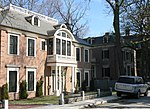William M. Davis House
Historic district contributing properties in MassachusettsHouses completed in 1898Houses on the National Register of Historic Places in Cambridge, MassachusettsNRHP infobox with nocatNational Historic Landmarks in Cambridge, Massachusetts

The William Morris Davis House is a National Historic Landmark on 17 Francis Avenue in Cambridge, Massachusetts. An architecturally undistinguished Queen Anne-era house, probably built in the 1890s, it is notable as the home of William Morris Davis between 1898 and 1916. Davis (1850-1934) was a professor of geology at Harvard University, and an influential figure in the development of meteorology and geomorphology as scientific disciplines. His textbook Elementary Meteorology was a standard of that field for many years. The house was declared a National Historic Landmark in 1976.
Excerpt from the Wikipedia article William M. Davis House (License: CC BY-SA 3.0, Authors, Images).William M. Davis House
Francis Avenue, Cambridge
Geographical coordinates (GPS) Address Nearby Places Show on map
Geographical coordinates (GPS)
| Latitude | Longitude |
|---|---|
| N 42.378416666667 ° | E -71.112222222222 ° |
Address
Francis Avenue 11
02143 Cambridge
Massachusetts, United States
Open on Google Maps









